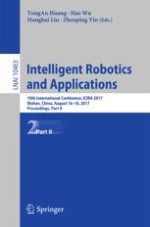2017 | Buch
Intelligent Robotics and Applications
10th International Conference, ICIRA 2017, Wuhan, China, August 16–18, 2017, Proceedings, Part II
herausgegeben von: YongAn Huang, Hao Wu, Honghai Liu, Zhouping Yin
Verlag: Springer International Publishing
Buchreihe : Lecture Notes in Computer Science
